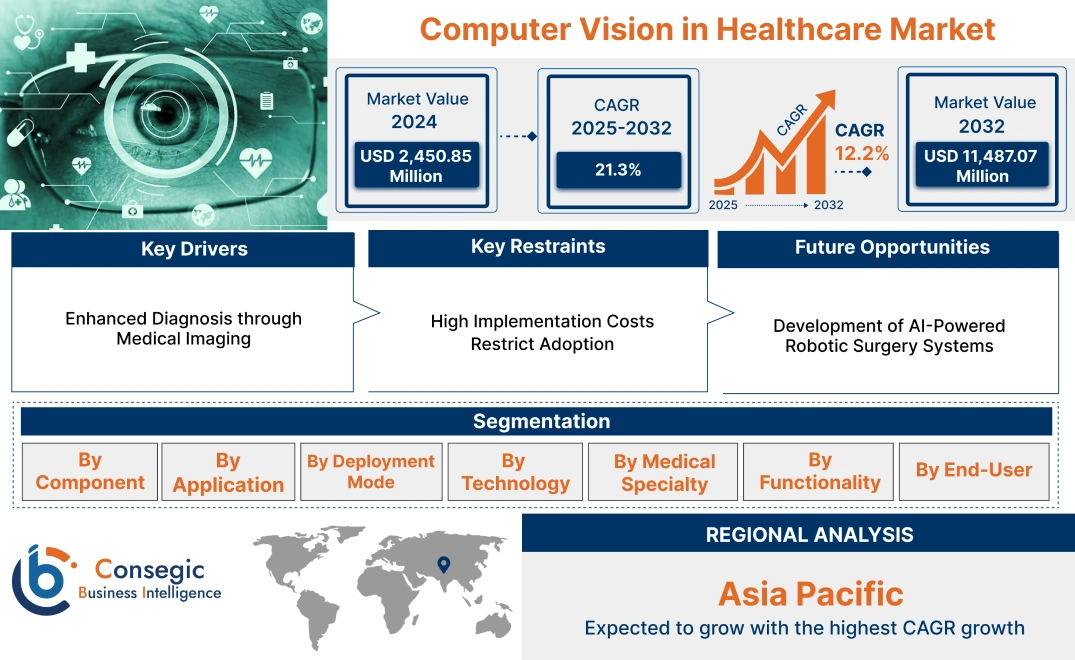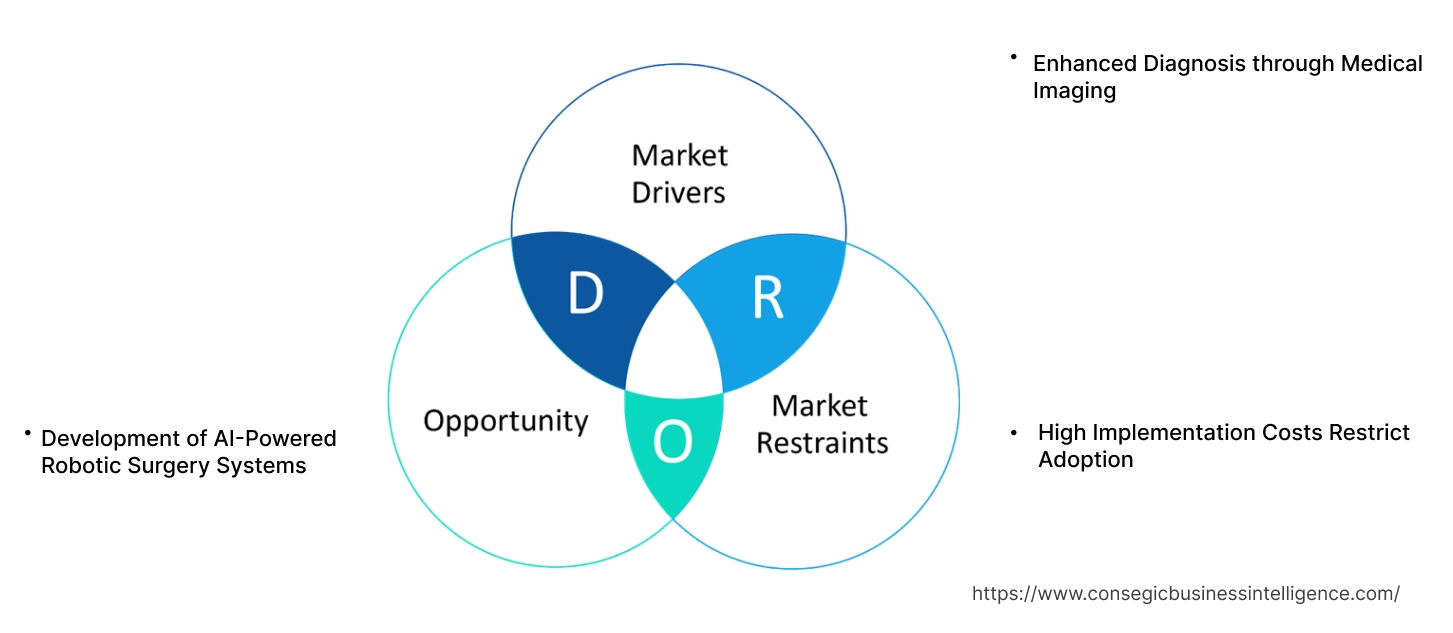- Summary
- Table Of Content
- Methodology
Computer Vision in Healthcare Market Size:
Computer Vision in Healthcare Market size is estimated to reach over USD 11,487.07 Million by 2032 from a value of USD 2,450.85 Million in 2024 and is projected to grow by USD 2,929.21 Million in 2025, growing at a CAGR of 21.3 % from 2025 to 2032.
Computer Vision in Healthcare Market Scope & Overview:
Computer vision in healthcare applies advanced algorithms to interpret medical images and videos for diagnostic, treatment, and administrative purposes. It incorporates deep learning techniques and artificial intelligence to analyze visual data accurately. This technology offers features such as real-time image analysis, automated disease detection, and precision in surgical assistance. It enhances workflows by integrating seamlessly with electronic health records and diagnostic systems.
Key benefits include improved diagnostic accuracy, reduced human error, and faster medical image interpretation. It aids in early disease detection, personalized treatment planning, and streamlined administrative processes. Applications span diagnostics, robotic surgery, patient monitoring, and healthcare management. End-use industries include hospitals, diagnostic centers, pharmaceutical companies, and research institutions leveraging computer vision to optimize medical care and innovation.
Key Drivers:
Enhanced Diagnosis through Medical Imaging
Medical imaging has significantly improved the accuracy and speed of disease detection and diagnosis. Computer vision technologies analyze medical images such as X-rays, MRIs, and CT scans, enabling healthcare professionals to identify abnormalities with greater precision. These tools enhance decision-making by highlighting key areas of concern, reducing the likelihood of missed diagnoses. For example, computer vision applications in detecting early-stage cancers like breast or lung cancer have shown high success rates.
Thus, the integration of computer vision in medical imaging propels advancements in diagnostic capabilities, augmenting the healthcare sector's effectiveness.
Key Restraints:
High Implementation Costs Restrict Adoption
The deployment of computer vision systems in healthcare involves substantial costs related to hardware, software, and technical expertise. Advanced imaging tools require high-end GPUs and AI-driven algorithms, which contribute to these expenses. Additionally, the training of healthcare personnel to use such technologies adds to the cost burden. Smaller healthcare providers and facilities in low-resource settings often face financial constraints, limiting their ability to adopt these advanced systems.
Therefore, high implementation costs act as a significant barrier, curbing the widespread adoption of computer vision technologies in the healthcare sector.
Future Opportunities :
Development of AI-Powered Robotic Surgery Systems
Future advancements in robotic surgery systems are expected to leverage computer vision for enhanced precision and control during procedures. These systems will utilize real-time visual data to guide robotic instruments, ensuring minimal invasiveness and improved surgical outcomes. For instance, integrating computer vision in robotic systems could improve procedures like tumor removal by enabling precise differentiation between healthy and diseased tissues.
Hence, the evolution of AI-powered robotic surgery systems presents a significant opportunity for the growth of computer vision applications in healthcare.
Computer Vision in Healthcare Market Segmental Analysis :
By Component:
Based on the component, the market is segmented into hardware, software, and services.
The hardware segment accounted for the largest revenue computer vision in healthcare market share by 46.50% in 2024.
- The hardware segment includes Graphics Processing Units (GPUs), Central Processing Units (CPUs), cameras, and sensors.
- GPUs and CPUs enhance computational efficiency, enabling faster processing of medical imaging data.
- Cameras and sensors are critical for capturing high-resolution images for diagnostic and surgical applications.
- Integration of advanced hardware components into healthcare systems supports real-time data processing and precise diagnostics.
- The development of specialized medical-grade hardware is further improving the reliability and performance of computer vision technologies in healthcare.
- Therefore, according to computer vision in healthcare market analysis, hardware components are essential for ensuring accurate and efficient computer vision operations in healthcare settings.
The services segment is anticipated to register the fastest CAGR during the forecast period.
- Services include implementation, support, and maintenance, which help integrate computer vision systems into existing healthcare infrastructures.
- Implementation services customize solutions for specific clinical needs, while support ensures uninterrupted operation.
- Increased adoption of AI-driven solutions has elevated trend for reliable and continuous support services in the healthcare sector.
- Service providers also assist with software updates and the integration of new technologies to keep systems optimized.
- The shift towards managed services in healthcare IT is likely to fuel the trend of this segment.
- Therefore, according to computer vision in healthcare market analysis, the rising reliance on technical expertise for system optimization and troubleshooting is propelling the services segment trend.
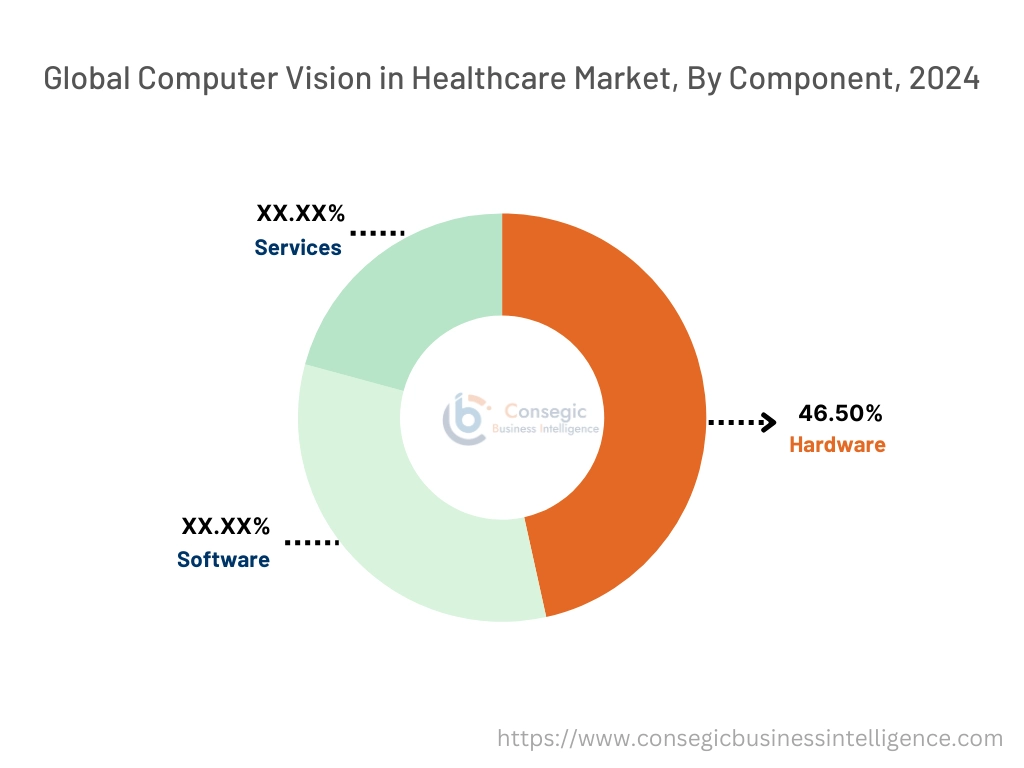
By Application:
Based on the application, the market is segmentsed into medical imaging & diagnostics, surgery assistance, patient monitoring, drug discovery, and others.
The medical imaging & diagnostics segment accounted for the largest revenue in computer vision in healthcare market share in 2024.
- Computer vision aids in detecting abnormalities like tumors, fractures, and organ irregularities through high-resolution imaging.
- It supports radiologists by automating repetitive tasks, reducing human error, and accelerating diagnosis times.
- The integration of AI algorithms in diagnostic imaging enhances accuracy and efficiency in disease detection.
- Advanced imaging technologies, such as 3D imaging and CT scans, are benefiting from enhanced computer vision algorithms.
- Computer vision-driven imaging helps provide early disease detection, which can lead to better patient outcomes.
- In conclusion, the application of computer vision in medical imaging transforms traditional diagnostics into precise, AI-enhanced procedures.
The surgery assistance segment is anticipated to register the fastest CAGR during the forecast period.
- Computer vision enables real-time guidance during minimally invasive surgeries, improving precision and reducing complications.
- It assists in pre-operative planning by analyzing patient-specific imaging data to provide detailed surgical roadmaps.
- Enhanced visualization technologies are driving adoption among surgeons for complex procedures.
- Integration with robotic systems is enhancing the functionality and accuracy of surgical assistance technologies.
- Surgeons are increasingly using computer vision for intra-operative decision support, further expanding its utility.
- In conclusion, advancements in visualization and AI-based assistance are accelerating the adoption of computer vision for surgical applications.
By Deployment Mode:
Based on deployment mode, the market is segmented into on-premises and cloud-based solutions.
The cloud-based segment accounted for the largest revenue share in 2024.
- Cloud-based solutions offer scalability, enabling healthcare providers to process and store large imaging datasets efficiently.
- They support seamless access to imaging data and reports across multiple locations, enhancing collaborative healthcare.
- Data security advancements in cloud computing have driven adoption among healthcare providers.
- Cloud platforms enable healthcare providers to access AI-powered diagnostic tools without heavy infrastructure investments.
- The flexibility of cloud computing allows for rapid scaling of computer vision applications across healthcare facilities.
- In conclusion, cloud-based deployment ensures efficient resource utilization and supports collaborative diagnostic efforts.
The on-premises segment is anticipated to register the fastest CAGR during the forecast period.
- On-premises deployment ensures data privacy and control, a critical requirement for sensitive healthcare information.
- It is preferred by large hospitals and specialized clinics with sufficient IT infrastructure to manage in-house systems.
- The increasing focus on compliance with stringent healthcare regulations is driving this segment’s trend.
- On-premises solutions are particularly beneficial for healthcare organizations with high data security concerns.
- The need for localized data storage and processing capabilities is expected to boost trend for on-premises deployments.
- In conclusion, on-premises solutions remain a crucial choice for healthcare providers prioritizing data sovereignty and security.
By Technology:
Based on technology, the market is segmented into machine learning, pattern recognition, deep learning, and context-aware computing.
The deep learning segment accounted for the largest revenue share in 2024.
- Deep learning algorithms analyze complex medical data for detecting intricate patterns, enhancing diagnostic precision.
- Applications include tumor detection, disease progression monitoring, and predicting treatment outcomes.
- Its ability to learn and improve over time makes it highly effective in handling diverse clinical scenarios.
- Deep learning models improve continuously with increased data availability, leading to higher accuracy in diagnostics.
- This technology also supports automation of image interpretation tasks, reducing the burden on medical professionals.
- In conclusion, deep learning drives significant advancements in healthcare diagnostics by offering unparalleled accuracy and adaptability.
The machine learning segment is anticipated to register the fastest CAGR during the forecast period.
- Machine learning optimizes patient care by enabling predictive analytics and automating repetitive diagnostic tasks.
- Its versatility spans various applications, including drug discovery, patient monitoring, and anomaly detection.
- Growing adoption of AI in personalized medicine is boosting the machine learning segment.
- Machine learning's ability to process vast amounts of clinical data makes it crucial for developing predictive models and personalized treatment plans.
- The segment benefits from continuous advancements in data collection and processing technologies.
- In conclusion, machine learning technologies play a transformative role in advancing personalized and efficient healthcare.
By Medical Specialty:
Based on medical specialty, the market is segmented into radiology, cardiology, oncology, neurology, pathology, and others.
The radiology segment accounted for the largest revenue share in 2024.
- Radiology leverages computer vision for enhancing image analysis, identifying abnormalities, and aiding in clinical decision-making.
- It improves radiologists’ efficiency by automating processes like lesion detection and classification.
- The rising computer vision in healthcare market demand for early disease detection has boosted the adoption of computer vision in radiology.
- AI-powered tools assist radiologists in reading and interpreting complex images like MRI and CT scans.
- The growth of telemedicine has further integrated computer vision into remote radiology practices.
- In conclusion, the integration of AI in radiology ensures accurate and efficient imaging services.
The oncology segment is anticipated to register the fastest CAGR during the forecast period.
- Computer vision assists in early cancer detection, tumor segmentation, and treatment monitoring.
- Its ability to analyze large datasets of histopathological images supports personalized oncology treatments.
- Increasing cancer prevalence has led to growing adoption of AI-driven diagnostic tools in oncology.
- Computer vision algorithms support the analysis of genomic and molecular data for cancer treatment planning.
- Advancements in imaging techniques allow for better detection of small tumors, contributing to improved patient outcomes.
- In conclusion, computer vision technologies significantly enhance cancer care by supporting precise diagnostics and personalized treatment planning.
By Functionality:
Based on functionality, the market is segmented into image analysis, video analysis, and text data analysis.
The image analysis segment accounted for the largest revenue share in 2024.
- Image analysis plays a crucial role in interpreting complex medical images for diagnosis and treatment planning.
- It improves efficiency in areas like radiology, pathology, and dermatology by providing accurate insights from imaging data.
- Increasing integration of AI with imaging modalities like MRI, CT, and X-ray supports segment growth.
- Image analysis helps in automating manual tasks, such as image classification and feature extraction.
- Advancements in 3D imaging and visualization further enhance the accuracy of image analysis tools.
- In conclusion, image analysis is the cornerstone of computer vision applications in healthcare, enabling precise diagnostics.
The video analysis segment is anticipated to register the fastest CAGR during the forecast period.
- Video analysis supports real-time monitoring during surgeries and assists in tracking patient movements in critical care.
- It enhances surgical precision by identifying anatomical structures and providing augmented reality overlays.
- Growing adoption of robotic-assisted surgeries is driving computer vision in healthcare market demand for advanced video analysis tools.
- Video analysis also plays a role in emergency response and monitoring the rehabilitation progress of patients.
- Integration with AI-based decision support systems allows for smarter clinical workflows and treatment adjustments.
- In conclusion, video analysis empowers real-time decision-making, revolutionizing surgical and patient monitoring applications.
By End-User:
Based on end-user, the market is segmented into hospitals & clinics, diagnostic centers, ambulatory surgical centers, and research institutions.
The hospitals & clinics segment accounted for the largest revenue share in 2024.
- Hospitals and clinics implement computer vision technologies for enhanced patient care, from diagnostics to post-operative monitoring.
- These facilities benefit from streamlined workflows, improved diagnostic accuracy, and reduced operational costs.
- Adoption is supported by government initiatives promoting AI in public healthcare systems.
- The presence of a large patient pool in hospitals and clinics drives the computer vision in healthcare market growth for automated and AI-supported solutions.
- Hospitals also leverage computer vision for remote monitoring and telemedicine applications.
- In conclusion, the broad application of computer vision in hospitals ensures efficient and patient-centric healthcare delivery.
The research institutions segment is anticipated to register the fastest CAGR during the forecast period.
- Research institutions utilize computer vision for drug discovery, molecular imaging, and advanced diagnostic research.
- Collaboration between academia and technology providers fosters innovation and speeds up the development of AI-driven solutions.
- Increasing funding for healthcare AI research is contributing to this segment's rapid growth.
- Research institutions also focus on developing novel AI-based tools to improve medical imaging and diagnostic capabilities.
- These institutions often serve as testing grounds for emerging computer vision technologies.
- In conclusion, the research institutions segment is critical for driving innovation in computer vision technologies in healthcare.
Regional Analysis:
The regional segment includes North America, Europe, Asia Pacific, Middle East and Africa, and Latin America.
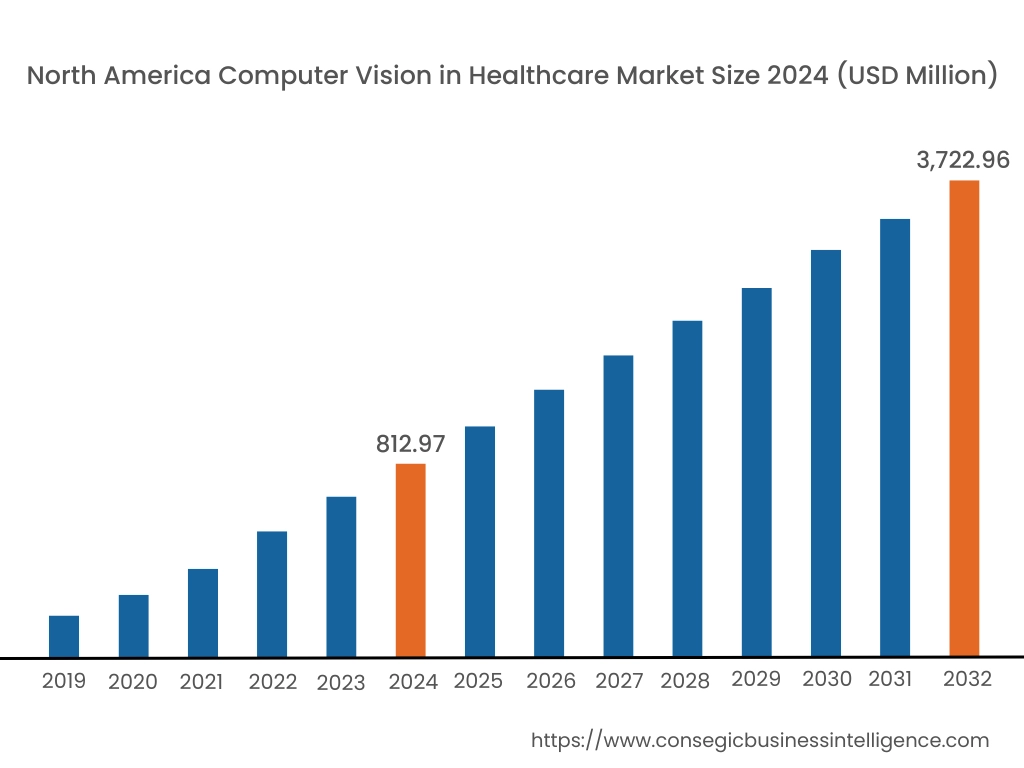
In 2024, North America was valued at USD 812.97 Million and is expected to reach USD 3,722.96 Million in 2032. In North America, the U.S. accounted for the highest share of 75.60% during the base year of 2024. North America holds the largest share of the concussions market, driven by heightened awareness of the risks associated with concussions in sports, military, and occupational settings. The United States leads the region with extensive research initiatives, strong healthcare infrastructure, and a focus on concussion prevention and treatment. Growing awareness campaigns and improved diagnosis rates, along with increased funding for concussion-related studies, support the market. The prevalence of concussions in contact sports, particularly football, contributes significantly to market expansion in this region.
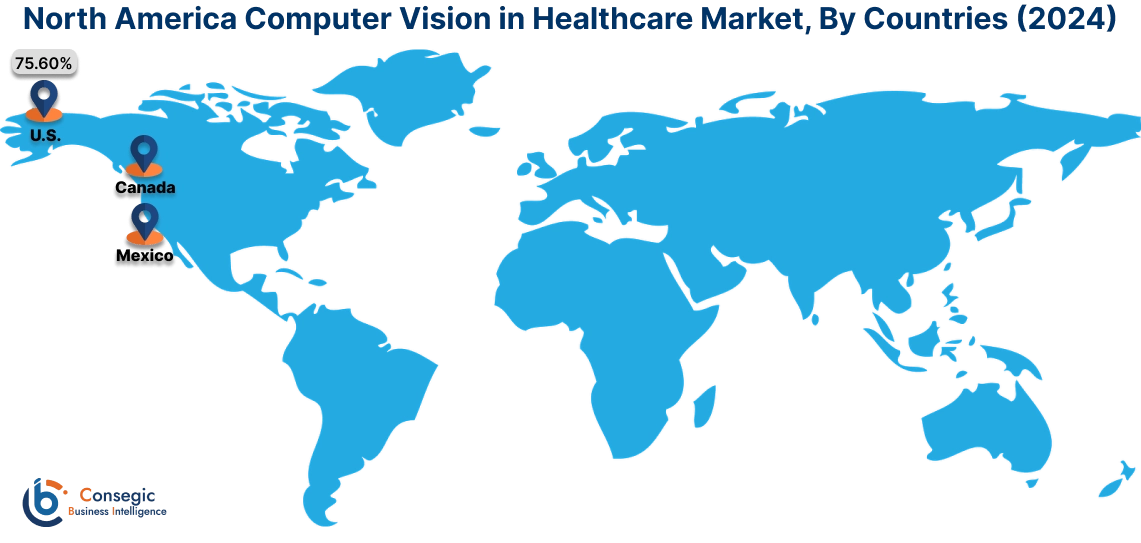
In Asia Pacific, the market is experiencing the fastest growth with a CAGR of 21.8% over the forecast period. The Asia-Pacific region is witnessing steady development in the concussions market, with countries like Japan, China, and India focusing on improving healthcare systems and awareness about concussion risks. Japan and Australia have implemented significant initiatives to manage concussions in sports, especially in rugby and soccer. In contrast, China and India face challenges related to limited awareness and healthcare infrastructure. However, the increasing participation in sports and the rising incidence of concussions are gradually creating a larger market for concussion treatment and management in the region.
Europe demonstrates a well-established market for concussion management, with countries like the United Kingdom, Germany, and France leading the way in research and treatment options. European countries are focused on improving sports-related concussion protocols and have implemented policies aimed at reducing concussion risks in youth sports. Rising sports participation and initiatives by organizations like UEFA and the European Commission to address concussion safety contribute to the computer vision in healthcare market growth. The region also benefits from strong healthcare systems, with many countries investing in concussion awareness, prevention, and treatment programs.
The Middle East and Africa region is still in the early stages of developing a structured concussion market. Awareness levels are relatively low, and healthcare infrastructure is underdeveloped in many African countries. However, countries in the Middle East, particularly the UAE and Saudi Arabia, are investing in healthcare advancements and starting to focus on concussion management, particularly in sports like football. In Africa, the market remains limited due to economic constraints, but growing sports popularity and increasing investments in healthcare are expected to improve the market landscape in the coming years.
In Latin America, the concussions market is expanding as sports, particularly soccer, continue to grow in popularity. Countries like Brazil, Argentina, and Mexico are increasingly focusing on improving concussion management protocols in professional and youth sports. However, the market is hindered by limited healthcare access, lack of awareness, and insufficient resources for concussion diagnosis and treatment. Governments and healthcare organizations are beginning to recognize the importance of concussion management, which is likely to improve the market outlook in the region over time.
Top Key Players and Market Share Insights:
The Global Computer Vision in Healthcare Market is highly competitive with major players providing products and servicesto the national and international markets. Key players are adopting several strategies in research and development (R&D), product innovation, and end-user launches to hold a strong position in the Global Computer Vision in Healthcare Market. Key players in the Computer Vision in Healthcare industry include-
- IBM Corporation (United States)
- Google Health (United States)
- Canon Medical Systems Corporation (Japan)
- Zebra Medical Vision (Israel)
- VUNO Inc. (South Korea)
- Microsoft Corporation (United States)
- Siemens Healthineers (Germany)
- GE Healthcare (United States)
- Philips Healthcare (Netherlands)
- NVIDIA Corporation (United States)
Recent Industry Developments :
Product launches:
- In March 2024, Siemens Healthineers introduced the Cinematic Reality app designed for the Apple Vision Pro, allowing users to view immersive and interactive holograms of the human body through medical scanning in real environments.
Mergers and Acquisitions:
- In July 2024, Medibank Private, an Australian health insurer, along with Macquarie Group, explored opportunities to acquire general practitioner (GP) clinics. Potential targets included BGH Capital's ForHealth, which oversees over 80 medical centers. This initiative was part of Medibank's strategy to expand its footprint in primary healthcare services.
Computer Vision in Healthcare Market Report Insights :
| Report Attributes | Report Details |
| Study Timeline | 2019-2032 |
| Market Size in 2032 | USD 11,487.07 Million |
| CAGR (2025-2032) | 21.3% |
| By Component |
|
| By Application |
|
| By Deployment Mode |
|
| By Technology |
|
| By Medical Specialty |
|
| By Functionality |
|
| By End-User |
|
| By Region |
|
| Key Players |
|
| North America | U.S. Canada Mexico |
| Europe | U.K. Germany France Spain Italy Russia Benelux Rest of Europe |
| APAC | China South Korea Japan India Australia ASEAN Rest of Asia-Pacific |
| Middle East and Africa | GCC Turkey South Africa Rest of MEA |
| LATAM | Brazil Argentina Chile Rest of LATAM |
| Report Coverage |
|
Key Questions Answered in the Report
How big is the Computer Vision in Healthcare Market? +
In 2024, the Computer Vision in Healthcare Market was USD 2,450.85 million.
What will be the potential market valuation for the Computer Vision in Healthcare Market by 2032? +
In 2032, the market size of Computer Vision in Healthcare Market is expected to reach USD 11,487.07 million.
What are the segments covered in the Computer Vision in Healthcare Market report? +
The component, application, deployment mode, technology, medical specialty, functionality and end-user are the segments covered in this report.
Who are the major players in the Computer Vision in Healthcare Market? +
IBM Corporation (United States), Google Health (United States), Microsoft Corporation (United States), Siemens Healthineers (Germany), GE Healthcare (United States), Philips Healthcare (Netherlands), NVIDIA Corporation (United States), Canon Medical Systems Corporation (Japan), Zebra Medical Vision (Israel), VUNO Inc. (South Korea) are the major players in the Computer Vision in Healthcare market.
